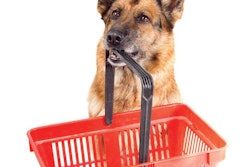
There’s nothing like a pandemic to highlight the globalization of the pet food market, along with the overall economy. Various regions depend on others for raw materials, finished products and many other elements crucial to keeping pet food flowing to all those hungry pets around the world; and some markets depend on others to buy their raw materials and finished products, keeping business flowing.
For example, Western Europe and Asia Pacific import a large amount of agricultural materials, including pet food ingredients like cereals/grains, meat and animal fats/meals and related products. According to data from Euromonitor International, Western Europe bought nearly US$200 billion in agricultural imports in 2018 and 2019, followed closely by Asia Pacific at about US$160 billion. All other regions had much lower agricultural imports, US$50 billion or below.
The heavy reliance on such imports puts those regions at some risk, said Jared Koerten, head of pet care for Euromonitor, during a webinar held July 9 in conjunction with Interzoo. “So if there is agricultural protectionism, if there are spikes in commodity prices, if there are shutdowns in global trade or issues with the global food supply chain, that could have a major impact on pricing and raw material availability, particularly in these regions that are more dependent on imports.”
Pet food imports and exports affected, too
Similar to the agricultural import situation, some regions or countries, including in those same regions of Western Europe and Asia Pacific, are more dependent on finished pet food product imports; the data presented by Koerten spotlighted the UK, Japan and Italy, especially relative to their lower levels of pet food exports.
On the other hand, markets like France, the U.S. and China dominate with pet food exports, and that can pose a risk in terms of being able to get products into other markets during a pandemic and in times of other potential supply chain disruptions, such as during trade disputes. (Ironically, despite ongoing tensions between the two countries, U.S. pet food companies now have an easier path for exporting into China thanks to a new protocol, effective June 15, developed by U.S. and Chinese envoys under the Phase One trade agreement.)
How e-commerce factors into the global pet food market
For the more import-reliant markets in Western Europe (plus others), pet food shortages became an issue during the height of the pandemic, even in the surging e-commerce channel. A tool set up by Euromonitor in March tracks pricing and stock status of many consumer goods, including pet food. Koerten shared data from the tracker showing out-of-stock status for dog food SKUs sold online in five markets in Western Europe: Belgium, France, Germany, Italy and U.K. Out-of-stock averages soared from an average of 5.3% in February to 12.1% in March, with some of the markets experiencing spikes of 15% to more than 20%.
These averages far exceeded online out-of-stock situations for dog food in Asia Pacific, according to Euromonitor, which were just under 6% at the highest level. In that region, e-commerce is much better established and has been popular for a longer time, Koerten said. In 2019, e-commerce accounted for 29% of the Asia Pacific pet care market, compared to only 10% for Western Europe. Thus, e-commerce merchants in the former region have had longer to establish an online infrastructure and the ability to adapt to surges in orders. “They’ve been through this before,” Koerten added.
Pet owners ordering their pet food online in other markets experienced delays in receiving the orders, at least those shipped to their homes from e-commerce retailers like Chewy in the U.S., Zooplus in Europe and Amazon globally. Yet that opened the door for what Koerten referred to as a “new guard”: companies and retailers offering omnichannel methods of ordering and delivering. For example, “click and collect,” where consumers order online and pick up at the store – or, nowadays, curbside.
Several large retailers have experienced triple-digit growth for these types of orders, according to Koerten, including Walmart and Target in the U.S., Carrefours in Europe and Tesco in the U.K. Another option – third-party delivery companies – has also enjoyed significant growth: Glovo, active in Europe and Latin American, has seen a 600% increase in orders; Instacart in the U.S., a 500% increase; and Rappi, in Latin America, has more than doubled its orders. These data apply to all consumer goods orders, not just pet food or pet care, but represent the tremendous changes affecting retailing today.
New model, hope for smaller pet retailers?
This new guard also offers an opportunity for pet and other brick-and-mortar (BAM) retailers, which were already losing business to the e-commerce surge; that has accelerated during the pandemic. Koerten shared Euromonitor’s global map showing traffic changes from January to June 2020 in retail locations or centers where consumers typically shop (and where pet retailers tend to be located, he noted). “The best-case scenario is a single-digit decline in foot traffic, and we’re not seeing many markets that have that,” Koerten said. “Most are looking at double-digit declines,” as high as 60% in some markets. Latin America retail has especially been affected, with nearly every country experiencing more than a 40% decrease in foot traffic.
In the U.S., Petco reported a 35% drop in foot traffic at its BAM locations from March to mid-April, according to David Lummis, lead pet market analyst for Packaged Facts, writing in Pet Product News and citing SafeGraph data. In a survey fielded by Packaged Facts in May, 69% of U.S. dog and cat owners reported shopping in BAM less, with 31% saying they were buying less in pet stores than six months previously.
However, like larger, general retailers, pet stores may see hope on the horizon from click and collect as well as home delivery. In the May survey, 34% of respondents said they were using curbside pickup more for grocery shopping, with 29% reporting they used grocery stores’ own delivery services more, Lummis reported; presumably for some, that included pet food and treats.
And while the survey didn’t measure such shopping methods at pet stores, they have been taking off, too. During an April webinar organized by the American Pet Products Association, Brannon Dixon, CEO of pet retailers Feeders Supply and Chow Hound Pet Supplies, said that in the immediate wake of the pandemic, home delivery orders for his stores more than tripled, while the “basket size” of those orders more than doubled. He characterized this as a benefit for pet specialty stores during the crisis, as his customers seemed willing to substitute brands for the convenience of being able to order them for home delivery or outside pickup.
What the future may hold for pet food retail
For pet food companies, pet specialty retailers are often a key ally, particularly for smaller, more specialized brands – making it even more important for those retailers to stay in business and continue to make sales in multiple channels and ways. “Retailers will be able to get more products out to the community, especially the indie-only brands that can’t be found in big-box stores, all while reaping the benefits of additional sales,” said Michael Baker president and CEO of distributor Pet Food Experts. He was quoted in another article in Pet Product News, by Marissa Heflin, on curbside pickup’s future in pet retail.
The consensus from Baker and other experts interviewed by Heflin: That future is bright. Perhaps pet owners’ affinity for smaller, local retailers will play a role: 79% of respondents to the Packaged Facts survey said that, due to the coronavirus, they believed it was especially important to buy from local, independent merchants. If those retailers can continue to make it more convenient and safe to do so, they might further encourage consumers to act on that belief.
View our continuing coverage of the coronavirus/COVID-19 pandemic.


















